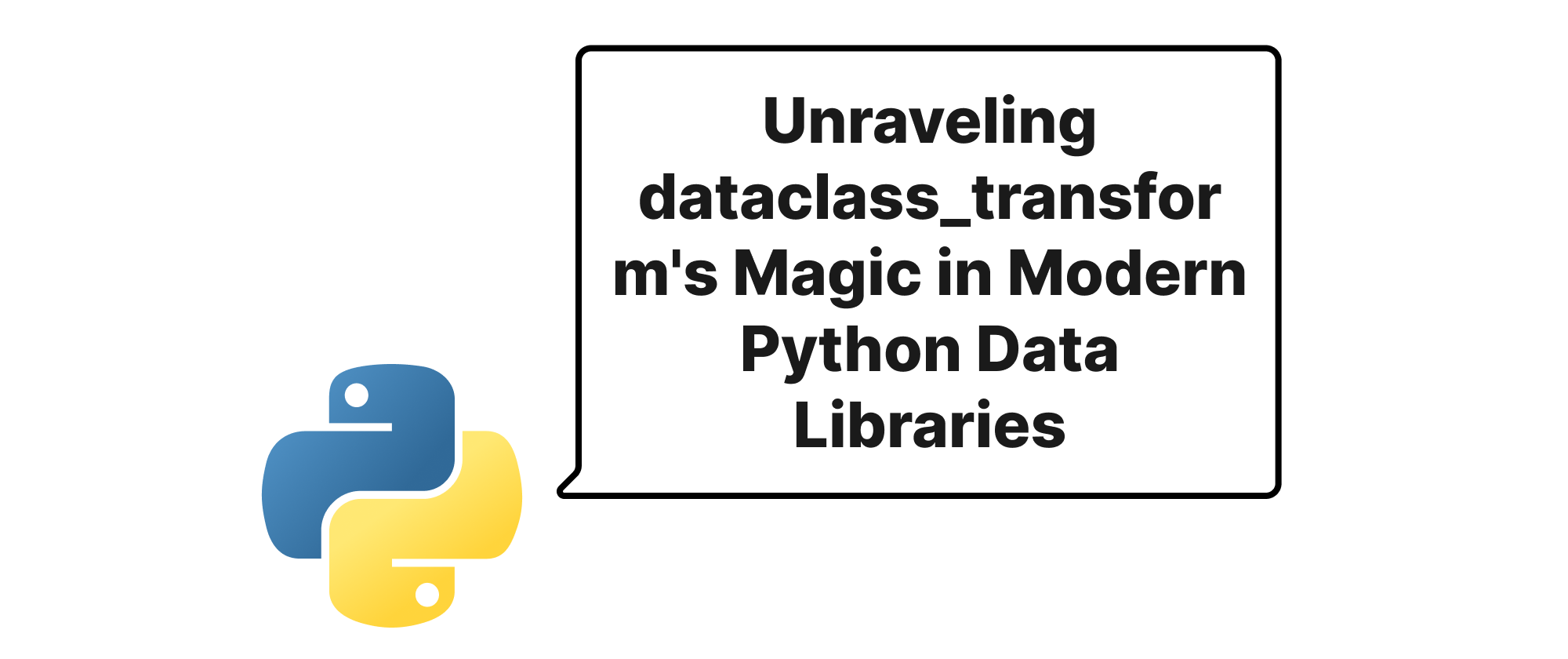Unraveling dataclass_transform's Magic in Modern Python Data Libraries
Emily Parker
Product Engineer · Leapcell

Introduction: The Evolving Landscape of Python Data Modeling
Python's journey in data modeling has seen remarkable advancements, moving from simple dictionaries to rich, type-hinted classes. Libraries such as Pydantic, SQLModel, and attrs have revolutionized how developers define, validate, and serialize data, bringing robust types and less boilerplate. A significant part of their appeal lies in their ability to offer intelligent type inference, autocompletion, and static analysis benefits – capabilities we’ve often taken for granted. But what’s the underlying mechanism enabling this seamless experience? The answer, at least in part, lies in a relatively new yet powerful addition to Python's typing module: typing.dataclass_transform. This article delves into the "new magic" that dataclass_transform brings, exploring its role in enhancing the developer experience within these popular data modeling libraries.
Understanding the Core Concepts
Before we dive into dataclass_transform, let's briefly touch upon some foundational concepts crucial for appreciating its utility.
- Type Hinting: Introduced in PEP 484, type hints allow developers to annotate variables, function parameters, and return values with expected types. They are a static analysis tool, helping linters and IDEs catch errors before runtime.
- Dataclasses: Part of Python's standard library (
dataclassesmodule), dataclasses (introduced in PEP 557) provide a decorator@dataclassthat automatically generates methods like__init__,__repr__,__eq__, etc., for classes primarily used to store data. They offer a concise way to define data-holding classes with type hints. - Class Transformations: Many libraries, like Pydantic and attrs, take a declarative class definition and transform it at runtime. This transformation often involves inspecting type hints to generate validation logic, serialization/deserialization methods, and attribute descriptors. However, standard type checkers aren't inherently aware of these runtime transformations.
The Problem dataclass_transform Solves
Historically, when you used a library like Pydantic, a class definition like this:
from pydantic import BaseModel class User(BaseModel): name: str age: int
would look like a standard class. However, BaseModel does significant runtime magic. For instance, when you instantiate User(name="Alice", age="25"), Pydantic implicitly validates age to be an integer (and attempts coercion if possible). Static type checkers, unaware of Pydantic's internal workings, might struggle to correctly infer types for dynamically added attributes or understand the semantic meaning of Pydantic's fields. This could lead to a less optimal developer experience, with potentially missed warnings or incomplete autocompletion.
typing.dataclass_transform: The New Magic
Enter typing.dataclass_transform, introduced in PEP 681. This decorator is not for end-users to apply directly to their classes. Instead, it's designed to be applied to decorator functions or base classes that themselves perform dataclass-like transformations. Its primary purpose is to signal to static type checkers that a particular decorator or base class is capable of transforming a decorated class into something resembling a dataclass.
When a type checker encounters a class that uses a decorator or inherits from a base class annotated with dataclass_transform, it understands that:
- Implicit Init Generation: The decorated/inherited class is likely to have an
__init__method generated, even if not explicitly defined. - Field Inference: Attributes defined with type hints will be treated as fields of the transformed class, with appropriate runtime behavior.
- Default Values and Required Fields: The type checker can infer the distinction between fields with default values (optional) and those without (required).
kw_onlyBehavior: It can understand if fields are keyword-only.
How Libraries Utilize It
Let's look at how Pydantic, SQLModel, and attrs leverage dataclass_transform.
Pydantic Example
Pydantic 2.0+ utilizes dataclass_transform. If you inspect pydantic.main.BaseModel, you'll find something similar to this (simplified for illustration):
# pydantic.main (conceptual, simplified) from typing import typing from typing import Any @typing.dataclass_transform( kw_only_default=False, field_specifiers=(Field, ...), # Field from pydantic.fields # ... other parameters ) class BaseModel: # ... pass
When you define your User class inheriting from BaseModel:
from pydantic import BaseModel, Field class User(BaseModel): name: str age: int = Field(gt=0) # Pydantic Field user = User(name="Alice", age=30) # Type checkers now better understand: # - User has an __init__ accepting name and age. # - age must be an int. # - The Field(gt=0) hint might be picked up by compliant type checkers for more advanced checks.
The dataclass_transform decorator on BaseModel signals to type checkers that classes inheriting from BaseModel will behave like dataclasses. This significantly improves static analysis, autocompletion in IDEs (like VS Code with Pyright or Mypy), and error detection. It helps type checkers understand that User will have an __init__ method derived from its fields, and that field types will be respected.
SQLModel Example
SQLModel, built on top of Pydantic and SQLAlchemy, also benefits immensely. Its SQLModel base class is decorated with dataclass_transform.
# sqlmodel.main (conceptual, simplified) from typing import typing from typing import Any @typing.dataclass_transform( kw_only_default=False, field_specifiers=(Field, Relationship, ...), # SQLModel's custom field types # ... other parameters ) class SQLModel: # ... pass
And your model:
from typing import Optional from sqlmodel import Field, SQLModel, create_engine class Hero(SQLModel, table=True): # table=True adds SQLAlchemy specific logic id: Optional[int] = Field(default=None, primary_key=True) name: str = Field(index=True) secret_name: str age: Optional[int] = Field(default=None, index=True) # Type checkers understand that: # - Hero has an __init__ # - id, name, secret_name, age are its fields # - Optional fields have default=None # - `Field` arguments like primary_key and index are recognized by the framework.
dataclass_transform ensures that type checkers correctly interpret Hero as a class with an auto-generated constructor and properties corresponding to its fields, despite the additional SQLAlchemy and Pydantic magic.
attrs Example
While attrs predates dataclass_transform and has its own sophisticated type stub generation, it can also leverage dataclass_transform for improved compatibility and adherence to a common standard for type checkers. Future versions or type stubs for attrs might apply dataclass_transform to its core attr.s decorator or attrs.define function.
# attrs.decorators (conceptual) from typing import typing @typing.dataclass_transform( kw_only_default=False, field_specifiers=(attr.field, ...), # attr.field ) def define(cls=None, **kwargs): # ... implementation of attrs decorator pass
When you define an attrs class:
import attrs @attrs.define class Point: x: int y: int p = Point(x=10, y=20) # Type checkers see x and y as defined fields and understand the __init__ correctly.
The integration of dataclass_transform helps standardize how type checkers understand these diverse data modeling frameworks, allowing them to provide consistent and accurate static analysis benefits.
The Parameters of dataclass_transform
dataclass_transform offers several parameters to fine-tune the transformation signal:
kw_only_default: (bool) IfTrue, fields are keyword-only by default.field_specifiers: (tuple[Any, ...]) A tuple of types that, when used as default values for attributes, denote a "field" (e.g.,pydantic.Field,attrs.field). This helps distinguish between regular default values and special field descriptors._params_specifiers: (tuple[Any, ...]) Similar tofield_specifiers, but for parameters that influence the transformation itself (e.g.,table=Truein SQLModel).
These parameters enable library authors to precisely inform type checkers about the specific behaviors of their transformation logic.
Conclusion: A Sharper Lens for Type Checkers
typing.dataclass_transform is a powerful, behind-the-scenes enhancement that significantly improves the static analysis capabilities of Python's type checking ecosystem. By providing a standardized way for libraries like Pydantic, SQLModel, and attrs to declare their dataclass-like transformation behaviors, it empowers type checkers to offer superior autocompletion, more accurate error detection, and a generally smoother developer experience. It's the silent enabler of much of the "magic" we appreciate in modern Python data modeling, making our code more robust and our development workflows more efficient. Ultimately, dataclass_transform serves as a critical bridge, harmonizing dynamic library transformations with the rigorous world of static type analysis.


